#gustave brion illustrations
Text
All my life I thought this illustration on the Internet was for Grantaire..
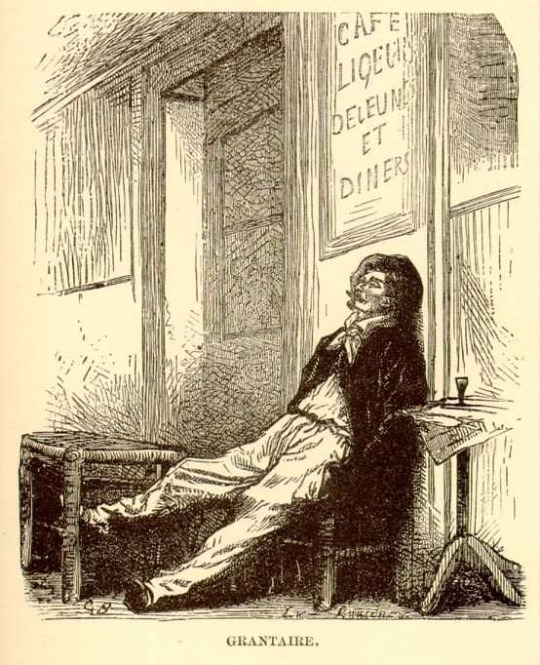
but when I went back to see something in my 1866 French illustrated edition by Gustave Brion which has the same illustration, I realized it was Bossuet!


I FEEL BETRAYEDDD
169 notes
·
View notes
Text
1885 edition of the brick!!!





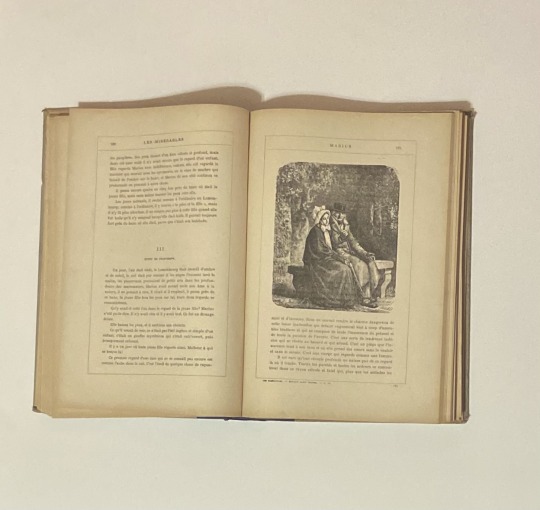


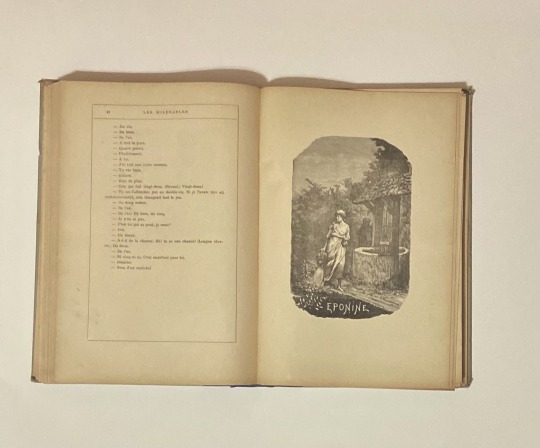
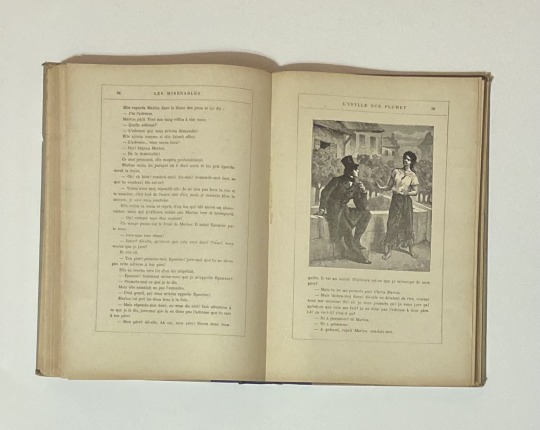





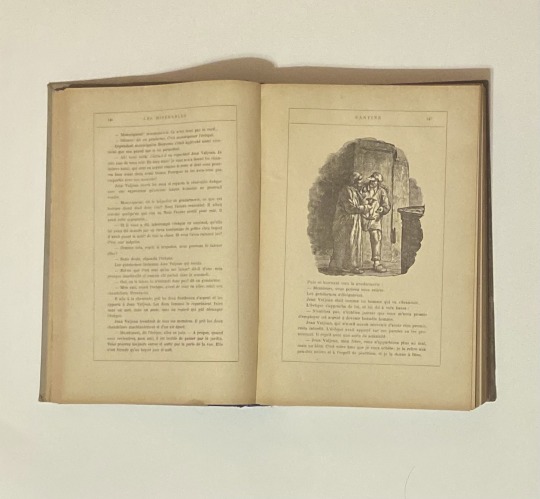
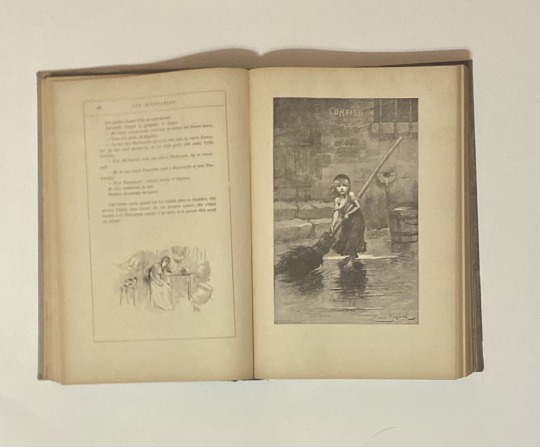



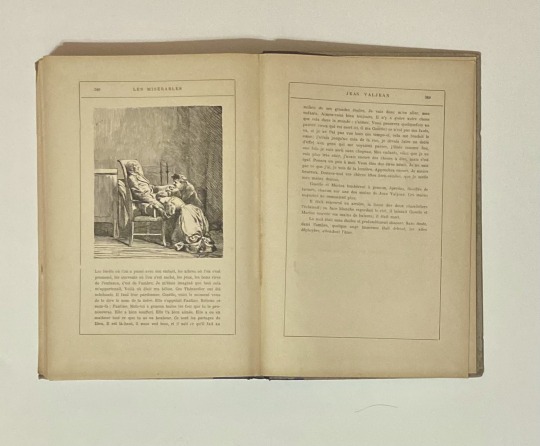
i get irrationally drawn to certain objects i see, and unfortunately, this pretty overpriced 1885 edition of les miserables was that item i was drawn to. i needed it.
from my research, this edition was printed all throughout the 1880s along with illustrated editions of many of hugo’s works.
i’m sure you recognize at least a couple of the illustrations here, as these are full of the classic gustav brion and emile bayard illustrations (including the famed one of cosette!)
these images are just a fraction of the amount of illustrations throughout it. it is PACKED with illustrations, almost every chapter having one as this edition has ones done by multiple artists. this clearly was even higher end for the time! it’s filled with illustrations, impressively large, sturdy covers, and i don’t know if it’s just me but the paper does feel stronger than some from books ive worked with or owned from this period.
while flipping through the pages, it definitely feels soulful. on several of the pages, there’s clearly a thumb indent from reading, which might be annoying to some. but to me it makes it all the more charming. clearly, someone throughly enjoyed it. whoever this person was, i feel connected to them a little bit.
this edition is BEAUTIFUL and i am very proud to own it!
#les mis#the brick#les miserables#i really hope someone as enthusiastic as me ends up with me bricks in 100 years#i want all my books to be donated to libraries and charities after i die (aside from one copy of les mis that i want to be buried with)#so i hope someone out there sees it and falls in love just like i did with this#im 99% sure this was very overpriced because i bought it for around 200 usd which is extremely expensive given the condition#and compared to similar editions prices#BUT I WANTED IT#so if anyone knows more about this im curious if got a terrible ripoff or an incredible deal
105 notes
·
View notes
Text

Gustave Brion (1824-1877), France. woodcarving. Les Mis illustration. probably depicts Javert's suicide.
27 notes
·
View notes
Text

From the Archives: A woodblock print of Valjean presenting the letter signed by Fantine to Thenardier, allowing him to take Cosette (and Catherine!) away.
The artist is Gustave Brion, my favorite of these old LM illustrators. Dated 1865.
32 notes
·
View notes
Photo

Jean Valjean, illustration from 'Les Miserables' by Victor Hugo (1802-85) 1862
(Jean Valjean, illustration from Les Miserables by Victor Hugo (1802-85) 1862 )
Gustave Brion
1 note
·
View note
Text

Illustration by Gustave Brion from 'Les Miserables' by Victor Hugo, Paris, 1867
45 notes
·
View notes
Text
Character ask: Madame Thénardier
Tagged by @ariel-seagull-wings
Favorite thing about them: Well, in the musical at least, she’s funny. Also, she gave birth to Éponine and Gavroche.
Least favorite thing about them: Her treatment of little Cosette and of her sons.
Three things I have in common with them:
*I’m heavyset.
*I have a temper, though hopefully I control it better than she does.
*I like romantic books.
Three things I don’t have in common with them:
*I’m not married.
*I’m not a mother.
*I would never abuse a child.
Favorite line:
Her verse in “Master of the House”:
“I used to dream that I would meet a prince,
But God Almighty, have you seen what’s happened since?
Master of the house isn’t worth my spit
Comforter, philosopher, and lifelong shit
Cunning little brain, regular Voltaire
Thinks he’s quite a lover, but there’s not much there
What a cruel trick of nature, landing me with such a louse!
God knows how I’ve lasted living with this bastard in the house!”
brOTP: No one.
OTP: Her husband. They’re a lousy couple, but I wouldn’t ship either of them with anyone else.
nOTP: Marius, Cosette, or any of her own children.
Random headcanon: Her husband has never beaten her. He favors psychological abuse instead, making her feel inferior and helpless without him. Her father (now long dead), on the other hand, did beat her. She had to have learned it from somewhere, and there has to be a reason besides her husband for her dislike of males.
Unpopular opinion: She’s not a worse person than her husband – at least she loves her daughters, while he loves no one – and it’s worthwhile to consider her vulnerability as a woman trapped in a dysfunctional marriage and in poverty. The refusal of some people to even consider any sympathy for her probably does stem partly from misogyny and fatphobia. That said, we shouldn’t bend over backwards to sympathize with her. She’s still cruel and ruthless and still a child abuser.
Song I associate with them:
“Master of the House,” namely the last part:
youtube
“Waltz of Treachery”:
youtube
Favorite picture of them:
This illustration by Gustave Brion:

Jenny Galloway, 10th Anniversary Concert, 1995:

Gina Ferrall, Broadway, 1996:
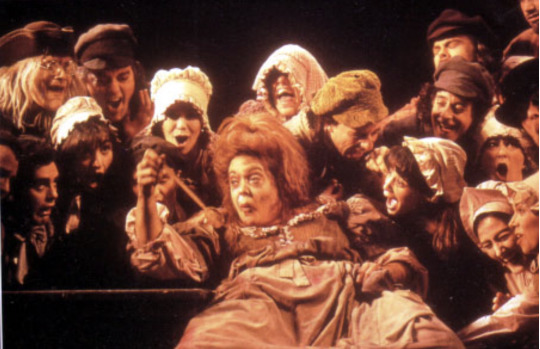
Fuschia Walker, Broadway, 1997:

Mandy Holliday, London, 2000:
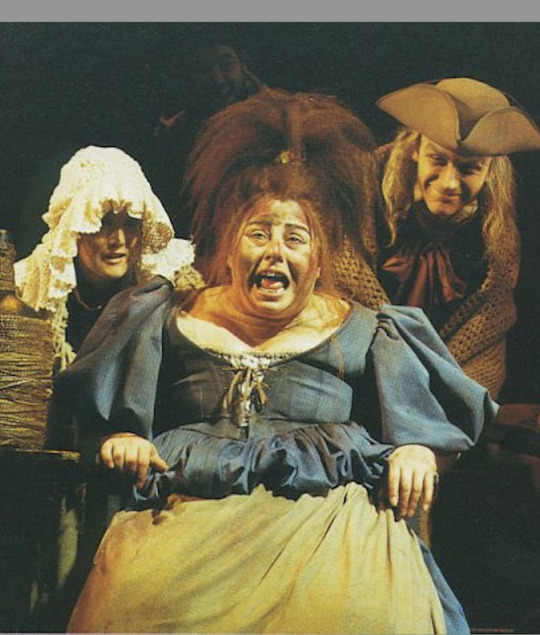
Betsy Joslyn (far removed from her “Johanna in Sweeny Todd” days), Broadway, 2002:
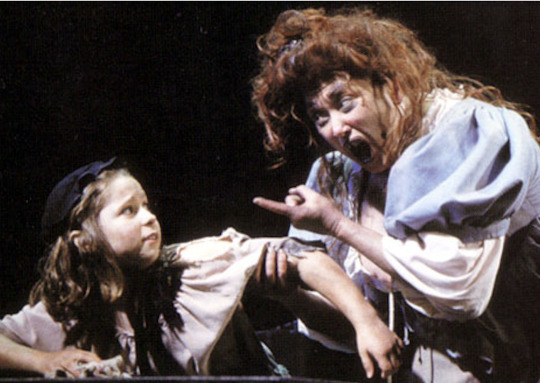
Aymee Garcia, Broadway, 2003:
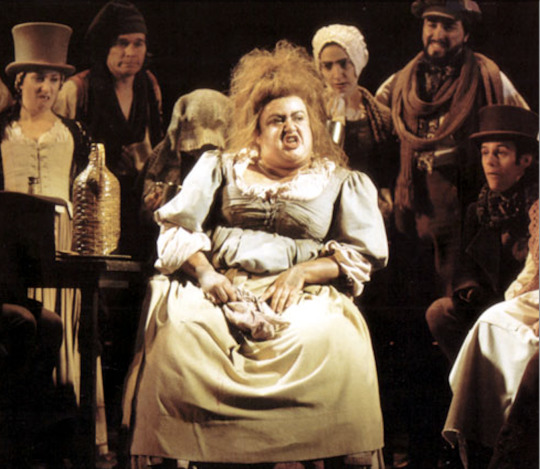
Jodi Capeless, 3rd National Tour, 2003:

Jennifer Butt, 3rd National Tour, 2004:

Helena Bonham Carter, 2012 film:

18 notes
·
View notes
Text

I posted 202 times in 2021
139 posts created (69%)
63 posts reblogged (31%)
For every post I created, I reblogged 0.5 posts.
I added 161 tags in 2021
#0 - 5 posts
#the hunchback of notre dame - 51 posts
#notre dame de paris - 39 posts
#quasimodo - 15 posts
#hunchback of notre dame - 12 posts
#disney - 12 posts
#history - 8 posts
#illustrations - 7 posts
#tab murphy - 6 posts
#victor hugo - 6 posts
Longest Tag: 86 characters
#there are isolated illustrations that i love but i don't know if the artists have more
My Top Posts in 2021
#5
youtube
This is an interview that I conducted with Tab Murphy, the screenwriter for Disney’s The Hunchback of Notre Dame. The purpose of this interview is to gain insight into the process of writing the film.
The historiography of the making of “Hunchback” has been primarily concerned with the artwork, direction, marketing, and music, with comparatively little being written or discussed about the writing process.
The task of adapting Victor Hugo’s sprawling historical melodrama into a children’s cartoon was not an easy one, and this interview sheds some light on how that was achieved.
Topics of Interest Include:
The writing process
The development of the story: proving that there was a “Disney film” in Hugo’s novel
How Murphy became involved with the project
Points of inspiration Murphy’s relationship with the story of “Hunchback”
Abandoned concepts/sequences
How scenes in the script were adapted into songs (The Hellfire song was based on a monologue from Frollo in the original script)
Was there an unhappy ending?
The initial reception of the movie contrasted with the current reception and reassessment of Tab Murphy’s work
I would like to thank Tab Murphy for his generosity and consideration and time.
Hopefully, this interview can be a source of historical reference and information and can give a perspective that has, for the most part, been underexplored with regard to the creation of this film.
Animated movies are the product of numerous creative voices, including that of screenwriters. If anyone ends up seeing this interview and learns something that they did not know before, feel free to share any and all knowledge. Even for something as simple as adding to the Wikipedia article for the movie.
Preservation is paramount.
48 notes • Posted 2021-04-21 20:48:55 GMT
#4
Personal Favorite NDdP artists and Illustrators:
Roland Wheelwright (6 years later, I need to upload better scans of these)

Nicholas Eustache Maurin

Gustave Brion
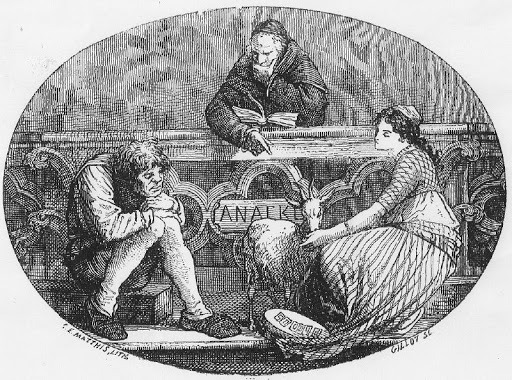
Luc Olivier Merson
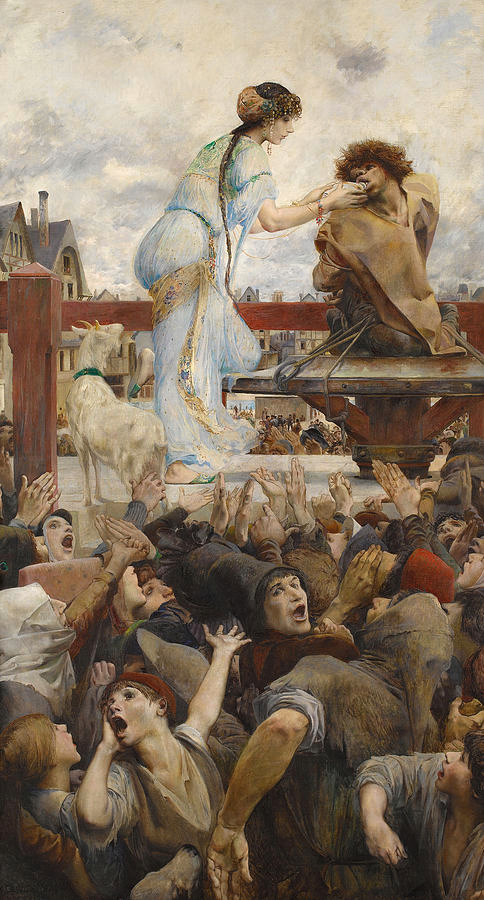
49 notes • Posted 2021-02-27 20:07:51 GMT
#3

On this day, 190 years ago, Victor Hugo’s immortal novel, Notre Dame de Paris, was published by Gosselin, after considerable delay. Almost immediately upon publication, the work was a popular success, capturing the minds of readers and numerous artists, musicians, and dramatists. Indeed, few works have been as admired, adapted, and imitated as this one.
The novel provides a narrative with characters who range from the very royalty of France to the lowliest of outcasts, with the shadow of the cathedral, whose survival is indebted to this book, looming over all.
Hugo writes that his story begins on a day in which history has forgotten, that “the sixth of January, 1482, is not a day that history has preserved any memory.” What a contrast to the sixteenth of March, 1831, in which the world welcomed one of the great literary works of all time.
49 notes • Posted 2021-03-16 15:55:40 GMT
#2

A soundtrack was recently announced for Disney’s The Hunchback of Notre Dame, which will not only include music that was not included as part of the original 1996 soundtrack album, but will also include multiple demos:
Notably, this album will include early versions of Heavens Light (reprise), Topsy Turvy, and A Guy Like You, which have never been released before. There are also two versions of out there, and only one has been made available in the past.
Many of the demos, I suspect, will be identical to the versions that were featured on the 1997 laserdisc edition of the movie.
Disappointingly, some of the songs that were on the laserdisc, such as heavens light, and the abandoned songs for the court of miracles scene, will not be included, and I am unsure as to why.
Still, this is a very exciting announcement, and from the historical perspective, it will always be a good thing to have more content available from the making of the film.
75 notes • Posted 2021-09-09 14:04:10 GMT
#1
The American version of Notre Dame de Paris (1956) is the superior version due to the inclusion of this bizarre scene.
89 notes • Posted 2021-03-05 13:09:34 GMT
Get your Tumblr 2021 Year in Review →
14 notes
·
View notes
Photo
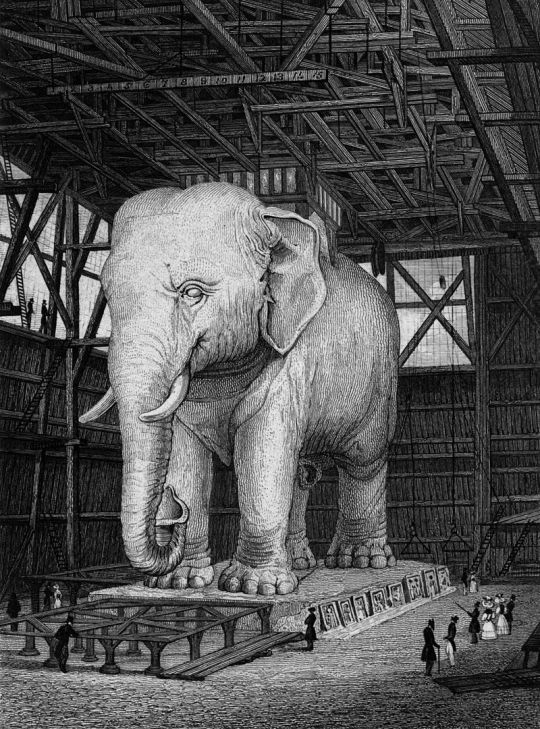
The Elephant of the Bastille was a monument in Paris which existed between 1813 and 1846. Originally conceived in 1808 by Napoléon I, the colossal statue was intended to be created out of bronze and placed in the Place de la Bastille, but only a plaster full-scale model was built. At 24 m (78 ft) in height the model itself became a recognisable construction and was immortalised by Victor Hugo in his novel Les Misérables (1862) in which it is used as a shelter by the street urchin Gavroche. It was built at the site of the Bastille and although part of the original construction remains, the elephant itself was replaced a few years later by the July Column (1835-40) constructed on the same spot.

^ View of the Elephant of the Bastille as it would have appeared in situ
Napoleon planned many urban regeneration projects for Paris and was particularly fond of monuments to his victories. He wanted to create a significant triumphal structure to demonstrate his military prowess and began the process of designing a 24 m (78 ft) bronze elephant. In the Imperial decree of 24 February 1811, he specified that the colossal bronze elephant be cast from the guns captured at the Battle of Friedland. A stairway would allow visitors to ascend one of the elephant's legs to an observation platform on its back, styled as a howdah.
Dominique Vivant was given the task of overseeing the project. Initially, Jacques Cellerier was chosen as the architect and work began in 1810 on the ground works, with the vaults and underground pipes completed by 1812. At this point Jean-Antoine Alavoine was chosen to replace him and the main pool was soon completed.
Alavoine, realising the need to show how the finished work would look, recruited Pierre-Charles Bridan to create a full-size model using plaster over a wooden frame. Completed in 1814, the model was protected by a guard named Levasseur who lived in one of the elephant's legs.
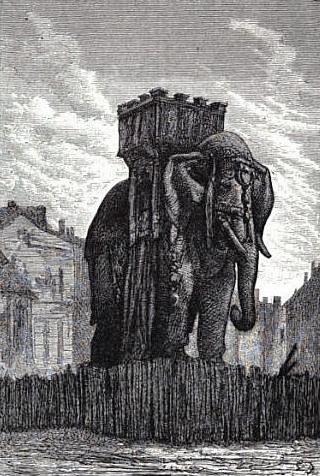
^ An 1865 illustration by Gustave Brion for Les Misérables, drawn 20 years after the monument had been destroyed.
The construction work stopped in 1815 after the defeat of Napoleon at the Battle of Waterloo. However, Alavoine was still seeking support to complete the project in 1833 and others also showed interest in finishing Napoleon's ambitious plans. In 1841 and 1843 the city council discussed options to complete the work using bronze, iron or copper, but none of the proposals were accepted. Nearby residents began to complain that rats were inhabiting the elephant and searching for food in their homes; and from the late 1820s, petitioned for demolition. The model elephant was not removed until 1846 by which time it showed considerable wear. The circular basin on which the elephant stood remains to this day and now supports the socle of the July Column.

^ Watercolour by architect Jean-Antoine Alavoine

^ 1834 engraving by an unknown artist

^ 1853 drawing by Gabriel Roux
40 notes
·
View notes
Text
Brick Club 3.7.3
Take a look at these criminals!

*Carefully puts away my lecture podium*
Gueulemer, given the choice to fight monsters, chooses to become one. This is a reversal fo the distinction Hugo makes of Javert, that he has chosen to guard society rather than attack it, although he (debatably) isn’t a worker of the mines as Gueulemer is. It took me a second to make the connection to Guillaume Brune because Wilbour translates “maréchal Brune” as “Marshal Brown.” Luckily I saw this post from @lizardrosen and @pilferingapples ahead of time, which also means I don’t have to pretend to have history knowledge because you should just read that post!
Babet “was an affected man, a great talker, who italicised his smiles and quoted his gestures.” He has the impossible to grasp, sleezy, exploitative charm of P.T. Barnum. Claquesous was the night before Batman was even a twinkle in the eye of the 1930s. His name is No-man. He skulks and sneaks like a level 20 rogue, which works for him until Enjolras (level 20 revolutionary) gets his hands on him.
The real reason everyone fixates on P-M, Montparnasse. Hugo said “Montparnasse was a fashion plate living in distress and committing murders” and every thirsty fangirl said “shippable.” First of all, he’s eighteen, he’s a child (pretty sure in 1831 Enjolras is 25), and oh also, he’s a heartless murderer.
Anyway, here’s another great illustration of P-M by Gustave Brion, who was the first illustrator for the book in 1862, conspicuously missing Montparnasse. The masks are interesting and, dare I say, it looks like Ward maybe took some inspiration?
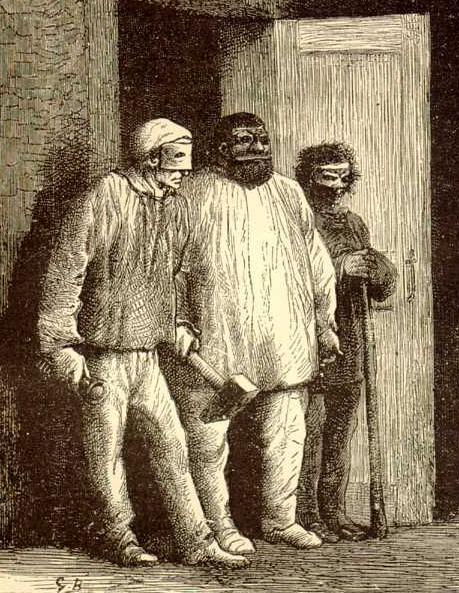
#brickclub#les mis#3.7.3#i like Hugos heavily stylized character introductions a lot#i had some notion to draw comparisons between P-M and emblematic mythical creatures just for pure self indulgence#gueulemer is clearly a golem-an assassin through nonchalance#babet is...some kind of trickster? like a grubby rumplestiltskin#claquesous is obviously a shade or ghost or some spook#its too easy to say montparnasse is a vampire maybe hes some kind of incubus
29 notes
·
View notes
Text
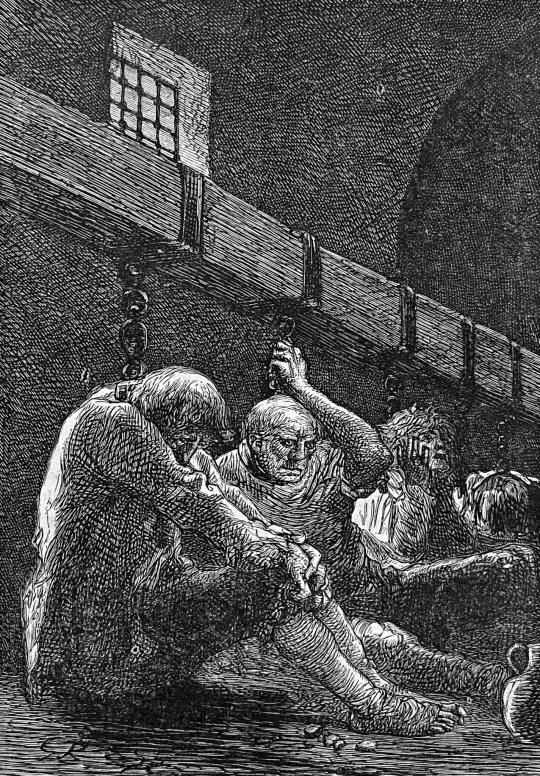

There existed at the Châtelet in Paris a large and long cellar. This cellar was eight feet below the level of the Seine. It had neither windows nor air-holes, its only aperture was the door; men could enter there, air could not. This vault had for ceiling a vault of stone, and for floor ten inches of mud. It was flagged; but the pavement had rotted and cracked under the oozing of the water. Eight feet above the floor, a long and massive beam traversed this subterranean excavation from side to side; from this beam hung, at short distances apart, chains three feet long, and at the end of these chains there were rings for the neck. In this vault, men who had been condemned to the galleys were incarcerated until the day of their departure for Toulon. They were thrust under this beam, where each one found his fetters swinging in the darkness and waiting for him.
— Les Misérables, IV.VII.II
1 | Illustrated by Gustave Brion (French Edition, 1866)
2 | Illustrated by Adriano Minardi (Italian Edition, 1930)
#les miserables#les mis#Slang#gustave brion illustrations#Adriano Minardi illustrations#illustration
74 notes
·
View notes
Text

I am on the point of death. What is it that you have come to ask of me?
Your blessing.
#les miserables#les mis#bishop myriel#the conventionist#(The Bishop Faces A New Light)#gustave brion illustrations#illustration
73 notes
·
View notes
Text
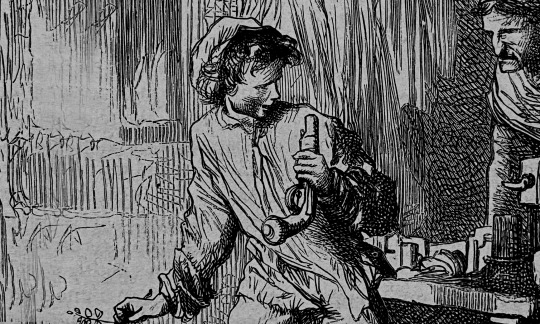

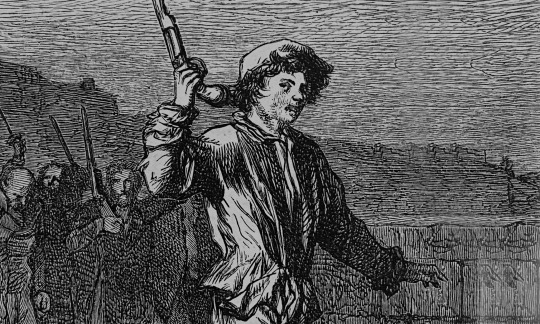
Les Misérables | Gavroche Thénardier ( Illustrated by Gustave Brion, 1866 )
Appreciation post for him and his gun <3
122 notes
·
View notes
Text


Towards the hour when workingmen repose, two men were seen to meet between the Barrière Picpus and the Barrière Charenton in a little lane between two walls, near a wine-shop, in front of which there was a “Jeu de Siam.” One drew a pistol from beneath his blouse and handed it to the other. As he was handing it to him, he noticed that the perspiration of his chest had made the powder damp. He primed the pistol and added more powder to what was already in the pan.
Then the two men parted.
— Les Misérables, IV.I.V
Illustrated by Gustave Brion (French Edition, 1866)
16 notes
·
View notes
Text

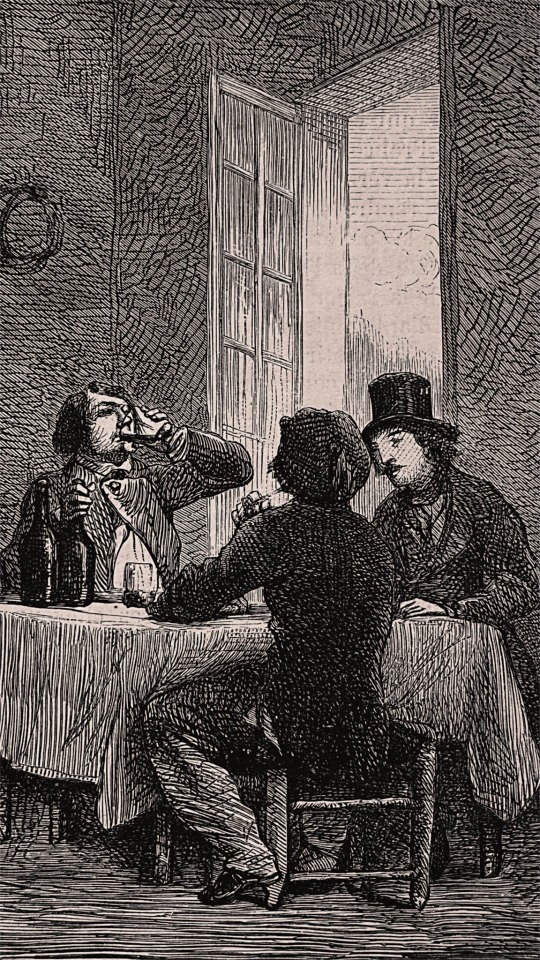
‘Well, then, let us drink.’
— Les Misérables | Grantaire, Bossuet and Joly Stay In Corinthe ( Illustrated By Gustave Brion, 1866 )
#les miserables#les mis#les amis#Bossuet#Laigle#grantaire#joly#( Stay In Corinthe )#gustave brion illustrations#illustration
142 notes
·
View notes
Text
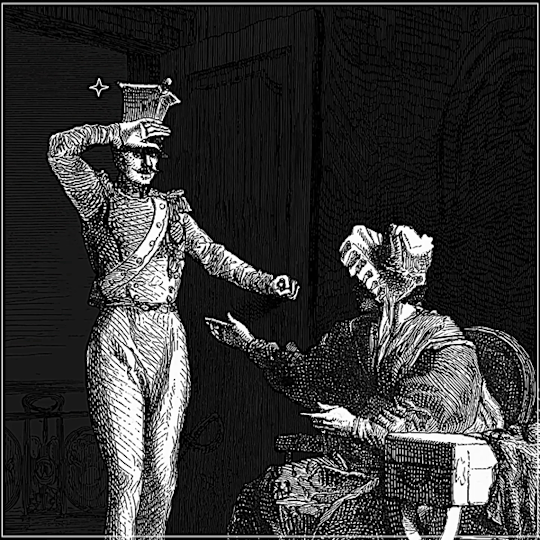

Les Misérables | Mlle Gillenormand Upon Seeing Theodule // M. Gillenormand With Theodule ( Illustrated By Gustave Brion, 1866 )
#les miserables#les mis#theodule#Mlle Gillenormand#m.gillenormand#gustave brion illustrations#illustration#my edit#I like the difference in their reaction when they see him
81 notes
·
View notes